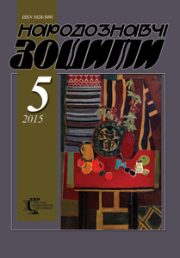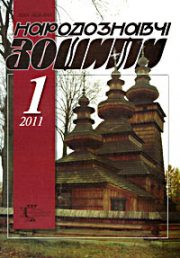The Ethnology Notebooks. 2024. № 6 (180), 1599—1603
DOI https://doi.org/10.15407/nz2024.06.1599
UKRAINIAN «ART CHRONICLE» WORLD WAR II (1939—1945)
KORNEV Andriy
- ORCID ID: https://orcid.org /0000-0002-0016-6954
- Candidate of Art History, Senior Teacher,
- Kharkiv State Academy of Design and Arts,
- 8, Street Mystetstv, 61000, Kharkiv, Ukraine
Abstract. The full-scale Russian-Ukrainian war has, in a certain way, brought the history of Ukrainian art to the forefront, particularly in relation to the role and place of fine art during major military conflicts. The most recent military conflict, to this day, is World War II. The so-called «artistic chronicle» of the Second World War, including its Ukrainian segment, described in hundreds of various publications, is, in the overwhelming majority, a legacy of the Soviet era. However, Ukrainian research has continued, and has been especially active in covering the anti-Bolshevik and anti-Soviet resistance through the lens of art. Now is the time to combine these two perspectives into a single understanding of the national component in Ukrainian art during World War II. This publication does not claim to be exhaustive, but it outlines the directions and concepts of the stated topic.
The first direction is propaganda and counter-propaganda, as they play an important role in the war, especially in the initial stage, when propaganda must simultaneously call for struggle and ideologically «destroy» the enemy (with counter-propaganda being based on this, in particular). The subject of the research presented here is primarily anti-Soviet and Soviet propaganda posters from 1939—1941.
A separate area of study is Soviet graphics from 1942 to 1944, as during this period, the duality of the Ukrainian «national question» in the context of the war emerges most clearly. Numerous documents from this period clearly indicate that art remained under centralized control and was directed in the manner prescribed «from above», that is, by the Soviet authorities. Therefore, the appearance of national Ukrainian elements (ethnographic, historical, cultural) in propaganda graphics is not accidental.
In parallel with ideological production, there was always another trend in Ukrainian military graphics, known as «trench» or «frontline» graphics. This can be explained by the fact that there were many artists among the Ukrainian soldiers, and in the frontline sketches they made directly from life during breaks between battles, the ideological component was almost completely absent.
The final shift in the artistic chronicle occurs at the end of the Second World War. In the official Soviet art of this period, neither the real poverty of ordinary people, nor the large number of disabled and crippled individuals broken by the war, nor the beggarly life on the brink of survival could be depicted. Some of these realities would appear in the counter-propaganda works of UPA artists and the Ukrainian diaspora, but this would happen only after 1945.
The research methodology is based on the complex involvement of various methods, principles and concepts.
Keywords: Ukrainian art of the Second World War; propaganda and counter-propaganda in art; Ukrainian «frontline» graphics.
Received 2.12.2024
REFERENCES
- Sklyarenko, G. (2007). Ukrainian Art of the 1930s—1950s: Stages, Directions, Works. Khudozhnia kultura. Aktualni problem (Issue 4, pp. 269—283). Kyiv [in Ukrainian].
- Tsinkovskaya, I., Yukhymets, H. (2004). Ukrainian Posters of the Great Patriotic War in the Collections of the National Library of Ukraine Named After V.I. Vernadsky. History of Ukraine. Little nown names, events, fakts (Issue 26, pp. 120—133). Kyiv [in Ukrainian].
- Maistrenko-Vakulenko, Yu. (2021). Frontline Drawing of Ukrainian Artists During the Second World War. Mystetstvoznavchi zapysky, 40, 57—66. DOI 10.32461/2226-2180.40.2021.250337 [in Ukrainian].
- Derevyanko, Yu., Kornev, A., & Tarasov, V. (2010). Our Victory. Kharkiv: Rarities of Ukraine [in Ukrainian].
- Portnov, G.S. (1958). Volodymyr Mykolayovych Kostetsky. Kyiv: Derzhavne vydavnytstvo obrazotvorchoho mystetstva i muzychnoi literatury URSR [in Ukrainian].






